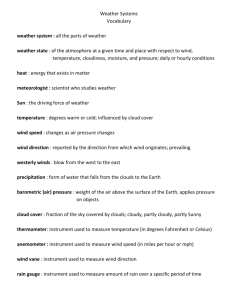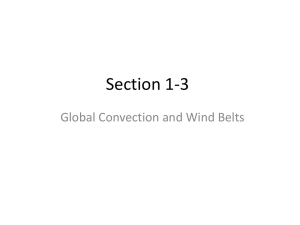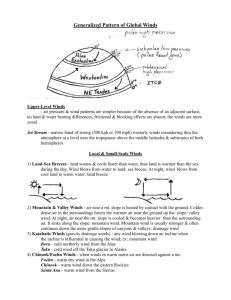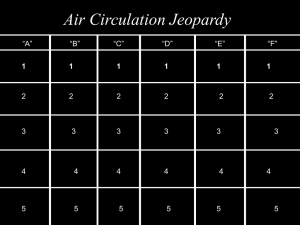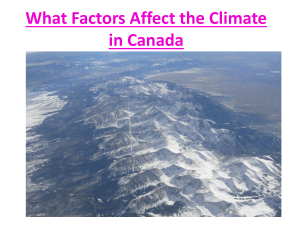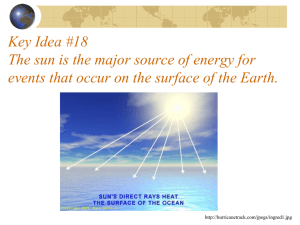Convection in the Atmosphere
advertisement
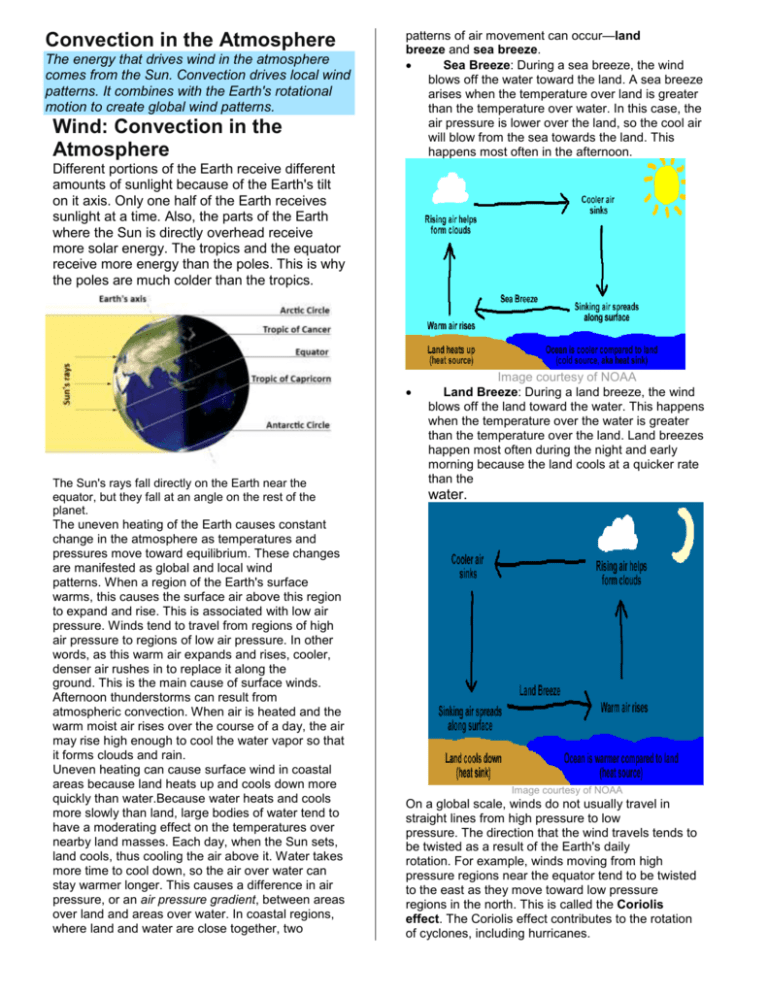
Convection in the Atmosphere The energy that drives wind in the atmosphere comes from the Sun. Convection drives local wind patterns. It combines with the Earth's rotational motion to create global wind patterns. Wind: Convection in the Atmosphere patterns of air movement can occur—land breeze and sea breeze. Sea Breeze: During a sea breeze, the wind blows off the water toward the land. A sea breeze arises when the temperature over land is greater than the temperature over water. In this case, the air pressure is lower over the land, so the cool air will blow from the sea towards the land. This happens most often in the afternoon. Different portions of the Earth receive different amounts of sunlight because of the Earth's tilt on it axis. Only one half of the Earth receives sunlight at a time. Also, the parts of the Earth where the Sun is directly overhead receive more solar energy. The tropics and the equator receive more energy than the poles. This is why the poles are much colder than the tropics. The Sun's rays fall directly on the Earth near the equator, but they fall at an angle on the rest of the planet. The uneven heating of the Earth causes constant change in the atmosphere as temperatures and pressures move toward equilibrium. These changes are manifested as global and local wind patterns. When a region of the Earth's surface warms, this causes the surface air above this region to expand and rise. This is associated with low air pressure. Winds tend to travel from regions of high air pressure to regions of low air pressure. In other words, as this warm air expands and rises, cooler, denser air rushes in to replace it along the ground. This is the main cause of surface winds. Afternoon thunderstorms can result from atmospheric convection. When air is heated and the warm moist air rises over the course of a day, the air may rise high enough to cool the water vapor so that it forms clouds and rain. Uneven heating can cause surface wind in coastal areas because land heats up and cools down more quickly than water.Because water heats and cools more slowly than land, large bodies of water tend to have a moderating effect on the temperatures over nearby land masses. Each day, when the Sun sets, land cools, thus cooling the air above it. Water takes more time to cool down, so the air over water can stay warmer longer. This causes a difference in air pressure, or an air pressure gradient, between areas over land and areas over water. In coastal regions, where land and water are close together, two Image courtesy of NOAA Land Breeze: During a land breeze, the wind blows off the land toward the water. This happens when the temperature over the water is greater than the temperature over the land. Land breezes happen most often during the night and early morning because the land cools at a quicker rate than the water. Image courtesy of NOAA On a global scale, winds do not usually travel in straight lines from high pressure to low pressure. The direction that the wind travels tends to be twisted as a result of the Earth's daily rotation. For example, winds moving from high pressure regions near the equator tend to be twisted to the east as they move toward low pressure regions in the north. This is called the Coriolis effect. The Coriolis effect contributes to the rotation of cyclones, including hurricanes. Uneven heating of the Earth's surface by the Sun's light causes winds.Winds tend to blow from regions of high pressure to regions of low pressure. However, the Earth's rotation twists these winds, so they do not move in perfectly straight lines. Some wind patterns occur high in the atmosphere. A jet stream is a quick-moving ribbon of air that moves from west to east high in the troposphere. Jet streams constantly shift their position. As the changes in position occur, air masses and weather systems in the path of the jet streams are moved by the quick-moving air. The Northern and Southern Hemispheres each have two main jet streams—a polar jet stream and a subtropical jet stream, shown in the image below. Global Wind Patterns The equator receives the most direct sunlight, so the water in that area is generally warmer than other areas. This causes moisture to evaporate from the ocean. The warm, moist air rises and creates a low pressure area. As you start to move north or south of the equator, the warm air eventually cools and sinks. Some of this cool air moves back towards the equator, the rest moves towards the poles. The cool air that flows back to the equator is called trade winds (between latitude 0° and 30°). Trade winds flow from east to west. These winds will come together at an area called the doldrums. The doldrums have little to no wind.However, the weather can be aggressive. In fact, most hurricanes originate in this area. This is an area that ships try to avoid due to the lack of wind and threatening weather. Hurricanes generally gain energy from the warm tropical waters. Hurricanes and other tropical weather systems usually move along in the direction of the trade winds (east to west). If a tropical weather system moves into the westerly winds region, however, it can move from west to east. Winds between 30° and 60° latitude are called prevailing westerlies. They are named based on the direction from which they originate. Because prevailing westerlies blow from west to east, weather patterns in the region also move from west to east. The United States and most of Canada lie in this region, and the region's temperatures are affected most by seasonal changes. At the poles, the air is quite cold. The dense air will sink and then spread away from the poles. These air formations are called polar easterlies (between latitude 60° and 90°). Again, these originate in the east and blow towards the west.They will eventually meet up with the westerlies, which reduces their motion. The following diagram illustrates the global wind patterns. Image courtesy of NOAA and NWS Image courtesy of NOAA and NWS In the Northern Hemisphere, the polar jet stream brings cold weather conditions from the north, and the subtropical jet stream brings warm weather conditions from the south. 1. Sunlight heats the ground, and the ground warms the nearby air. The warm air expands and rises, while cool air rushes in to take its place. The example above describes the process that generates many surface winds. Surface winds are an example of _______ in the Earth's atmosphere. A. condensation 2. B. conduction C. convection D. radiation Which of the following factors drives all the weather on Earth, including large-scale storms and local weather systems? A. The Coriolis Effect curves the motion of wind due to the Earth's rotation. B. The Greenhouse Effect ensures that some of the Sun's heat will be trapped close to Earth. C. The Sun heats up the air at different rates and the atmosphere must try to equalize temperatures and pressures. D. The ocean holds the heat of the Sun more efficiently than the land. 3. 4. 5. 6. 7. 8. Convection currents, which affect weather and climate, are created by A. slow, constant tectonic movement. B. erosion of ocean beaches. C. mining of the seafloor. D. the uneven heating of the Earth. A _______ is a quick-moving ribbon of air that moves from west to east high in the atmosphere. This air current constantly bends and dips down to move weather systems around. A. global wind B. ribbon wind C. torrent D. jet stream Ocean currents and global wind patterns, which are caused by convection currents, most strongly affect a region's A. climate. B. latitude. C. day length. D. population size. In general, air masses along the southern U.S. tend to be made up of high-pressure air. Air closer to the north pole tends to be low pressure air. Why does the high pressure air from the south not blow straight to the north? A. Because the Earth's rotation twists the wind's path to the east. B. Because the Earth's surface is heated evenly, canceling out any pressure differences. C. Because winds blow from areas of low pressure to areas of high pressure. D. Because the Earth's rotation twists the wind's path to the west. Warm air expands and rises, creating an area of _______; cold air is dense and sinks to create an area of _______. A. convection, conduction B. high pressure, low pressure C. conduction, convection D. low pressure, high pressure 15. Solar energy heats the surface of the Earth, including the ground, rocks, and even roadways. As the temperature of these surfaces increases, heat energy is released back into the atmosphere, forming a pocket of warm air. As the warm air pocket rises, it is replaced by cooler air. This process is responsible for many of the weather patterns in our atmosphere, and is known as 9. A. conduction. B. convection. C. evaporation. D. transpiration. Weather is best defined as A. a prediction of atmospheric conditions in the coming season. B. a pattern of regional temperature, precipitation, and humidity. C. the study of the entire atmosphere and how it changes over time. D. the state of the atmosphere at a given time and place. 10. The atmosphere is heated both by the Sun and by the Earth's surface. Water radiates heat differently than land, so the air temperature over the ocean is usually different than the air temperature over land. The difference in air temperature over land compared to over water causes convection currents in the atmosphere. How would a person at the beach experience these convection currents? A. They would feel that the sand is hot. B. They would feel the heat of the Sun. C. They would feel wind as the air moves. D. They would feel that the water is cold. 11. The Gulf Stream passes from the Gulf of Mexico, northward along the coast of eastern North America, and eastward toward Ireland, the United Kingdom, and Scandinavia. Without the Gulf Stream, these regions would be colder than they are. How does the Gulf Stream keep these regions warm? A. It encourages evaporation, which makes the land dry and warm. B. It washes floating ice sheets away from the coasts. C. It absorbs cold temperatures from the land. D. It brings warm water, which heats the overlying air. 12. Global winds are found in each convection region. Because convection cells are in a set place in the atmosphere and the Earth is spinning on its axis, the winds appear to curve. The apparent curving of the winds is called _______. A. the Coriolis effect B. the global wind effect C. the Curvature effect D. atmospheric curving


